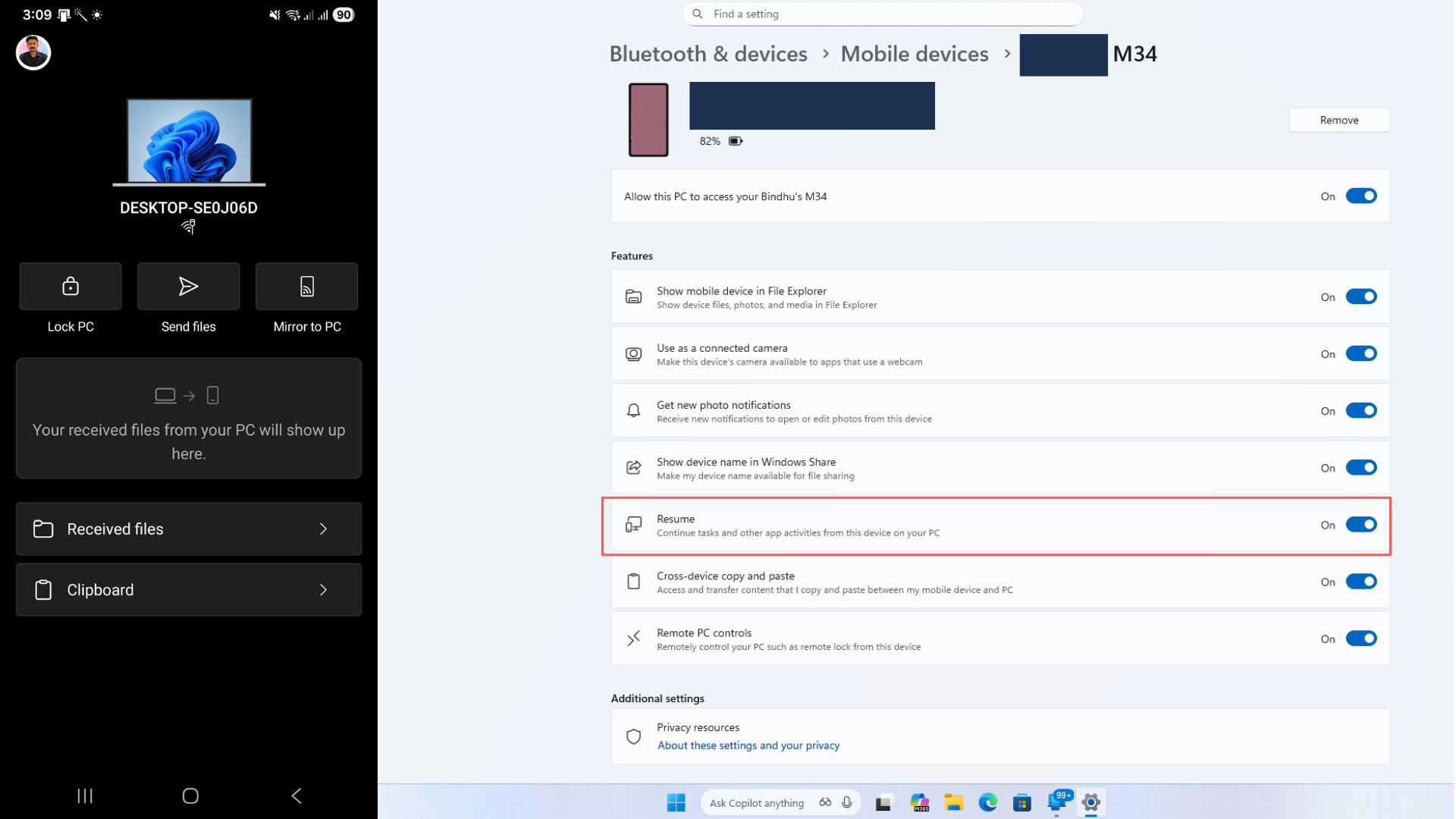Microsoft’s latest Windows 11 Insider Preview Build 26220.7271 brings a new cross-device feature that lets you resume what you were doing on your Android phone directly on your Windows PC. The M365 Copilot app on your phone from some brands can now hand off your browsing activity or cloud documents to the PC with a single click.
This update builds on Microsoft’s earlier rollout in August, where only Spotify supported cross-device resume. The system works through the Link to Windows app and Microsoft’s Continuity SDK, which quietly sends “app context” from your phone to the PC so Windows can reopen the same activity.
Your PC can now resume online files from the M365 Copilot Android app
The new Insider Preview update for Dev and Beta channels brings support for continuing online Word, Excel, and PowerPoint files opened inside the M365 Copilot app on your Android phone.
Microsoft says that if these Office apps are installed on your PC, the files open there. If not, Windows opens the online version in your browser. Note that it only works for online documents, since local files still stay locked to your phone.

Currently, only phones from Samsung, Honor, Huawei, Oppo, and Vivo have this feature. The absence of Xiaomi and Motorola looks strange for now, because both brands have a good presence in several markets. As expected, Google’s Pixel lineup are also absent from the list.
If you use a Vivo phone, you can now pick up your Vivo Browser session on your Windows 11 PC’s default browser without having to do anything extra. The phone sends the active tab to your PC, and Windows shows a small alert on the taskbar that opens the same page in your PC browser.
How the cross-device resume actually works
Windows Latest understands that, at the technical level, all of this works through the Link to Windows app and a background layer that Microsoft calls the Continuity SDK.
Your phone creates a small “context packet” that contains the app, the content you are using, and instructions on how your PC should continue it. Windows receives that packet through the Cross Device Experience Host and launches the correct app or browser tab.

Cross-device resume runs on top of Microsoft’s Continuity SDK, which gives Android apps a way to describe what the user is doing and hand that context over to Windows. The core piece here is what Microsoft calls AppContext.
It is a small packet of metadata that tells Windows what activity the user wants to resume, which app it came from, when it was created, and where it should resume on the PC. Every AppContext needs a unique ID, a creation time, an app ID, and a type (in this case, resume activity).
If they choose to, developers can attach a preview image, a title, an intent URI, or a weblink.
Info Notice
Windows uses this metadata to figure out whether it should launch a desktop app through a registered URI protocol or fall back to opening a link in the browser.
However, the handoff only works if the partner app has integrated the Continuity SDK correctly. The app must initialize the SDK, wait for a onContextRequestReceived callback from Link to Windows, and then send its AppContext using AppContextManager.sendAppContext. If the system disconnects, the app must stop sending context.
Link to Windows is the background process that keeps everything connected. So, if your phone suspends it from running in the background, maybe to save battery, this feature may not work as intended.
Link to Windows runs on your phone, maintains the link to the PC, and receives each AppContext the moment the app pushes it. If the SDK sees that the phone and PC are linked and the context is valid, Windows generates a resume alert on the taskbar.
Resume alerts won’t appear unless a few conditions are met.
The phone must have Link to Windows running in the background, the user must have paired the phone with the PC, and the partner app must be approved by Microsoft because resume is a limited-access API. Apps also need explicit approval to interact with Link to Windows.
On the Windows side, as of now, the device must be running Insider Build 26220.7271 with CDEH (Cross Device Experience Host) provisioning so the system can understand the AppContext schema and activate the right desktop app through URI or weblink.
Microsoft’s documentation also explains why offline files on phones are not supported yet. A resume handoff only works when the file or activity can be referenced through a URI or a weblink. Offline files stored locally on the phone do not have a sharable endpoint that Windows can open, so the resume pipeline cannot hand them over. That is why only online Word, Excel, and PowerPoint files opened in the M365 Copilot app qualify for this experience right now.
However, the documentation doesn’t explain why only Samsung, Honor, Huawei, Oppo, and vivo support cross-device resume. But the Resume API is a Limited Access Feature that requires OEM apps to integrate the Continuity SDK, add specific metadata, and work closely with the Link to Windows service. Only manufacturers that have completed this integration are currently supported.
Cross Device Resume sounds good on paper, but getting it to work is hard
I use a Motorola phone, so the feature isn’t available for my device, despite Motorola’s growing popularity in the US.
Undeterred, I got to work with my mom’s Samsung phone to test the feature. I am on the Dev channel with the latest Insider Build. All permissions in Link to Windows are enabled. The same Microsoft account is up and running on the M365 app as well. I have also manually enabled the feature. However, after multiple tries, the feature didn’t work.
But you can try your luck with the steps below:
How to enable the new Resume-from-Phone feature in Windows 11
- Install the latest Windows 11 Insider Preview Build 26220.7271 (KB5070307) in the Dev or Beta Channel.
- Go to Settings > Bluetooth & devices > Mobile devices.
- Turn on “Allow this PC to access your mobile devices.”
- Click Manage devices, and pair your Android phone (Samsung, Honor, Huawei, Oppo, or vivo) via Bluetooth.
- Open the Link to Windows app on your phone, follow the setup prompts, and make sure the app is allowed to run in the background.
- In the Manage Devices setting on your PC, make sure that “Resume” feature is turned on.

- Now, trigger a resume event and if everything works well, you’ll see the resume car appear on your PC taskbar. Click it to continue the activity on your PC.
These are the three cross-device resume features available now:
- Vivo Browser for browser-session resume
- M365 Copilot app for online Word, Excel, and PowerPoint files
- Spotify (earlier rollout) for audio resume
Microsoft is trying to make up for the lack of an ecosystem
Microsoft clearly wants Windows to have its own version of Apple’s Handoff, where you can start something on one device and pick it up on another. The intention is good, and the tech behind it is exceptional.
But the execution is far from the perfect experience that Apple users are so used to by now, that once they buy one Apple product, the chances of them completing the “ecosystem” are pretty high.
Of course, the biggest issue here is Android’s fragmentation. Unlike Apple’s walled garden, Android is a collection of different manufacturers. Without OEM-level integration of the Continuity SDK and the required metadata, Windows doesn’t hold a candle against Apple’s Handoff.
Speaking of Apple, iPhones are out of this conversation entirely as Microsoft notes “iOS applications are not supported for integration with the Continuity SDK at this time.”
Getting the Phone Link iOS app to run in the background alone would be a gargantuan task for Microsoft. As for iPhone users who have a Windows PC, we believe that cross device resume feature would take a fairly long time to arrive, unless Microsoft works out any miracles, which we are wishing they would, considering that Apple is planning to launch a budget MacBook soon.
And the iPhone users who didn’t let go of their Windows PC till now, just because they don’t want to spend a fortune on Apple hardware, may finally switch to macOS, and never look back. The implications of a budget MacBook entering the $800 Windows PC monopoly are staggering.
All hope is not lost as Microsoft still can woo Android OEMs to get their devices to talk better with Windows. These manufacturers want it as much as Microsoft because it’s the only way for them to grow their market share.
Before that happens, Microsoft has a few things to fix. The resume pipeline needs to get more reliable, the device list should expand beyond a handful of OEMs, and the onboarding process for developers needs to be much simpler than the current Limited Access Feature request system.
That being said, if you’re a developer and you want to add cross device resume in your app, well, Microsoft is actually inviting people like you to do so. Check out the Microsoft support document for Cross Device Resume (XDR) using Continuity SDK (Android and Windows Applications).
The feature is currently rolling out to Insiders in the Dev and Beta channels only, and there is no word on when it will come to regular PCs.
The post Microsoft is using Windows 11 taskbar to resume your Android activities appeared first on Windows Latest
